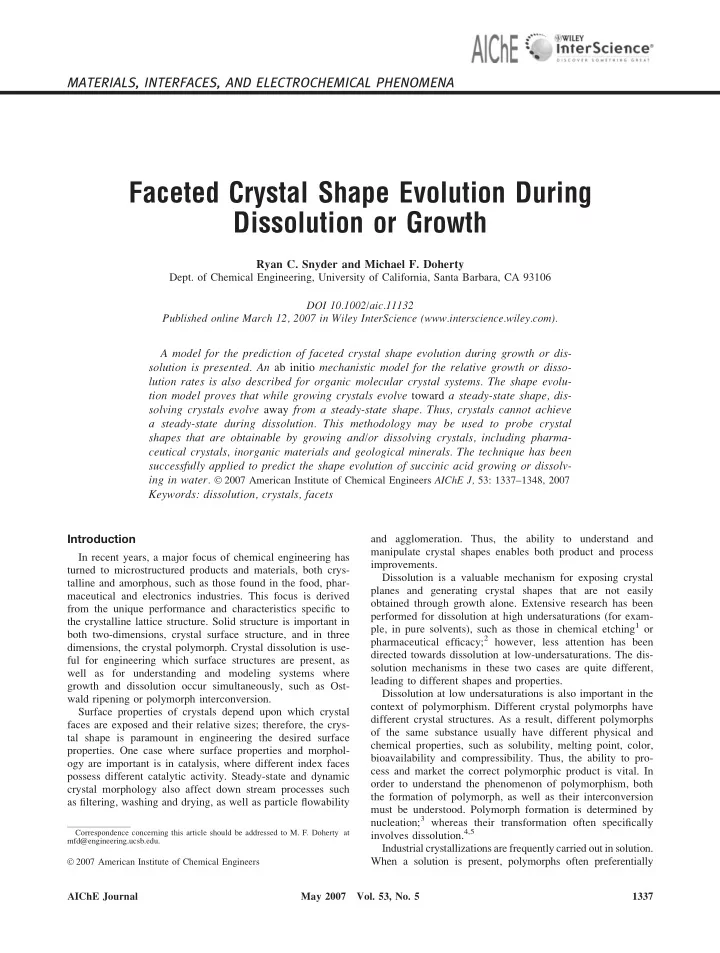

MATERIALS, INTERFACES, AND ELECTROCHEMICAL PHENOMENA Faceted Crystal Shape Evolution During Dissolution or Growth Ryan C. Snyder and Michael F. Doherty Dept. of Chemical Engineering, University of California, Santa Barbara, CA 93106 DOI 10.1002/aic.11132 Published online March 12, 2007 in Wiley InterScience (www.interscience.wiley.com). A model for the prediction of faceted crystal shape evolution during growth or dis- solution is presented. An ab initio mechanistic model for the relative growth or disso- lution rates is also described for organic molecular crystal systems. The shape evolu- tion model proves that while growing crystals evolve toward a steady-state shape, dis- solving crystals evolve away from a steady-state shape. Thus, crystals cannot achieve a steady-state during dissolution. This methodology may be used to probe crystal shapes that are obtainable by growing and/or dissolving crystals, including pharma- ceutical crystals, inorganic materials and geological minerals. The technique has been successfully applied to predict the shape evolution of succinic acid growing or dissolv- ing in water. � 2007 American Institute of Chemical Engineers AIChE J, 53: 1337–1348, 2007 Keywords: dissolution, crystals, facets Introduction and agglomeration. Thus, the ability to understand and manipulate crystal shapes enables both product and process In recent years, a major focus of chemical engineering has improvements. turned to microstructured products and materials, both crys- Dissolution is a valuable mechanism for exposing crystal talline and amorphous, such as those found in the food, phar- planes and generating crystal shapes that are not easily maceutical and electronics industries. This focus is derived obtained through growth alone. Extensive research has been from the unique performance and characteristics specific to performed for dissolution at high undersaturations (for exam- the crystalline lattice structure. Solid structure is important in ple, in pure solvents), such as those in chemical etching 1 or both two-dimensions, crystal surface structure, and in three pharmaceutical efficacy; 2 however, less attention has been dimensions, the crystal polymorph. Crystal dissolution is use- directed towards dissolution at low-undersaturations. The dis- ful for engineering which surface structures are present, as solution mechanisms in these two cases are quite different, well as for understanding and modeling systems where leading to different shapes and properties. growth and dissolution occur simultaneously, such as Ost- Dissolution at low undersaturations is also important in the wald ripening or polymorph interconversion. context of polymorphism. Different crystal polymorphs have Surface properties of crystals depend upon which crystal different crystal structures. As a result, different polymorphs faces are exposed and their relative sizes; therefore, the crys- of the same substance usually have different physical and tal shape is paramount in engineering the desired surface chemical properties, such as solubility, melting point, color, properties. One case where surface properties and morphol- bioavailability and compressibility. Thus, the ability to pro- ogy are important is in catalysis, where different index faces cess and market the correct polymorphic product is vital. In possess different catalytic activity. Steady-state and dynamic order to understand the phenomenon of polymorphism, both crystal morphology also affect down stream processes such the formation of polymorph, as well as their interconversion as filtering, washing and drying, as well as particle flowability must be understood. Polymorph formation is determined by nucleation; 3 whereas their transformation often specifically involves dissolution. 4,5 Correspondence concerning this article should be addressed to M. F. Doherty at mfd@engineering.ucsb.edu. Industrial crystallizations are frequently carried out in solution. When a solution is present, polymorphs often preferentially � 2007 American Institute of Chemical Engineers AIChE Journal May 2007 Vol. 53, No. 5 1337
Recommend
More recommend